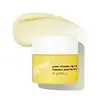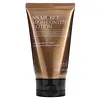What's inside
What's inside
 Key Ingredients
Key Ingredients

 Benefits
Benefits

 Concerns
Concerns

 Ingredients Side-by-side
Ingredients Side-by-side

Phytosteryl/Isostearyl/Cetyl/Stearyl/Behenyl Dimer Dilinoleate
Skin ConditioningDiisostearyl Malate
EmollientHydrogenated Polyisobutene
EmollientPolybutene
Hydrogenated Poly(C6-14 Olefin)
EmollientMicrocrystalline Wax
Emulsion StabilisingEuphorbia Cerifera Wax
Polyglyceryl-2 Triisostearate
EmulsifyingEthylene/Propylene/Styrene Copolymer
C12-15 Alkyl Benzoate
AntimicrobialCI 77891
Cosmetic ColorantCaprylyl Glycol
EmollientAlumina
AbrasiveAluminum Stearate
Cosmetic ColorantPolyhydroxystearic Acid
EmulsifyingBenzotriazolyl Dodecyl P-Cresol
UV AbsorberEthylhexylglycerin
Skin ConditioningButylene/Ethylene/Styrene Copolymer
Citrus Junos Peel Oil
AstringentPentaerythrityl Tetra-Di-T-Butyl Hydroxyhydrocinnamate
AntioxidantTocopherol
AntioxidantWater
Skin ConditioningGlycerin
HumectantPropanediol
SolventHydrogenated Lecithin
EmulsifyingAscorbic Acid
AntioxidantCaprylic/Capric Triglyceride
MaskingPanthenol
Skin ConditioningOctyldodecanol
EmollientCeramide NP
Skin ConditioningPolyglyceryl-10 Stearate
Skin ConditioningPantolactone
HumectantCholesterol
EmollientStearic Acid
CleansingSodium Ascorbyl Phosphate
Antioxidant1,2-Hexanediol
Skin ConditioningNiacinamide
SmoothingSh-Oligopeptide-1
Skin ConditioningSh-Polypeptide-1
Skin ConditioningBiotin
AntiseborrhoeicPyridoxine
Skin ConditioningFolic Acid
Skin ConditioningSh-Polypeptide-9
Skin ConditioningSh-Polypeptide-7
AntiseborrhoeicSh-Oligopeptide-2
Skin ConditioningSh-Polypeptide-45
Skin ConditioningSh-Oligopeptide-14
Skin ConditioningCyanocobalamin
Skin ConditioningLinoleic Acid
CleansingThiamine Hcl
MaskingBeta-Carotene
Skin ConditioningInositol
HumectantRiboflavin
Cosmetic ColorantLimonene
PerfumingLinalool
PerfumingPhytosteryl/Isostearyl/Cetyl/Stearyl/Behenyl Dimer Dilinoleate, Diisostearyl Malate, Hydrogenated Polyisobutene, Polybutene, Hydrogenated Poly(C6-14 Olefin), Microcrystalline Wax, Euphorbia Cerifera Wax, Polyglyceryl-2 Triisostearate, Ethylene/Propylene/Styrene Copolymer, C12-15 Alkyl Benzoate, CI 77891, Caprylyl Glycol, Alumina, Aluminum Stearate, Polyhydroxystearic Acid, Benzotriazolyl Dodecyl P-Cresol, Ethylhexylglycerin, Butylene/Ethylene/Styrene Copolymer, Citrus Junos Peel Oil, Pentaerythrityl Tetra-Di-T-Butyl Hydroxyhydrocinnamate, Tocopherol, Water, Glycerin, Propanediol, Hydrogenated Lecithin, Ascorbic Acid, Caprylic/Capric Triglyceride, Panthenol, Octyldodecanol, Ceramide NP, Polyglyceryl-10 Stearate, Pantolactone, Cholesterol, Stearic Acid, Sodium Ascorbyl Phosphate, 1,2-Hexanediol, Niacinamide, Sh-Oligopeptide-1, Sh-Polypeptide-1, Biotin, Pyridoxine, Folic Acid, Sh-Polypeptide-9, Sh-Polypeptide-7, Sh-Oligopeptide-2, Sh-Polypeptide-45, Sh-Oligopeptide-14, Cyanocobalamin, Linoleic Acid, Thiamine Hcl, Beta-Carotene, Inositol, Riboflavin, Limonene, Linalool
Butylene Glycol
HumectantGlycerin
HumectantCetyl Ethylhexanoate
EmollientNiacinamide
SmoothingPentylene Glycol
Skin Conditioning1,2-Hexanediol
Skin ConditioningPalmitic Acid
EmollientStearic Acid
CleansingSimmondsia Chinensis Seed Oil
EmollientSorbitan Olivate
EmulsifyingAloe Barbadensis Leaf Juice
Skin ConditioningAlthaea Rosea Root Extract
HumectantAloe Barbadensis Leaf Extract
EmollientBeta-Glucan
Skin ConditioningXanthan Gum
EmulsifyingPanthenol
Skin ConditioningSodium Hyaluronate
HumectantSalix Alba Bark Extract
AstringentPlantago Asiatica Extract
Skin ConditioningLaminaria Digitata Extract
Skin ProtectingDiospyros Kaki Leaf Extract
Skin ProtectingUlmus Campestris Bark Extract
AstringentCaprylyl Glycol
EmollientPolyglyceryl-10 Laurate
Skin ConditioningSnail Secretion Filtrate
Skin ConditioningCetearyl Olivate
Helianthus Annuus Seed Oil
EmollientCitric Acid
BufferingTripeptide-1
Skin ConditioningMyristic Acid
CleansingUsnea Barbata Extract
Glyceryl Stearate
EmollientEthylhexylglycerin
Skin ConditioningPulsatilla Koreana Extract
Skin ConditioningUrea
BufferingHexapeptide-11
Skin ConditioningPalmitoyl Pentapeptide-4
Skin ConditioningBee Venom
AstringentSh-Oligopeptide-1
Skin ConditioningLecithin
EmollientTocopheryl Acetate
AntioxidantCopper Tripeptide-1
Skin ConditioningWater
Skin ConditioningPalmitoyl Tripeptide-1
Skin ConditioningHexapeptide-9
Skin ConditioningPolysorbate 20
EmulsifyingZanthoxylum Piperitum Fruit Extract
Skin ConditioningBehenyl Alcohol
EmollientCarthamus Tinctorius Seed Oil
MaskingLauric Acid
CleansingArgania Spinosa Kernel Oil
EmollientTocopherol
AntioxidantCetearyl Alcohol
EmollientButylene Glycol, Glycerin, Cetyl Ethylhexanoate, Niacinamide, Pentylene Glycol, 1,2-Hexanediol, Palmitic Acid, Stearic Acid, Simmondsia Chinensis Seed Oil, Sorbitan Olivate, Aloe Barbadensis Leaf Juice, Althaea Rosea Root Extract, Aloe Barbadensis Leaf Extract, Beta-Glucan, Xanthan Gum, Panthenol, Sodium Hyaluronate, Salix Alba Bark Extract, Plantago Asiatica Extract, Laminaria Digitata Extract, Diospyros Kaki Leaf Extract, Ulmus Campestris Bark Extract, Caprylyl Glycol, Polyglyceryl-10 Laurate, Snail Secretion Filtrate, Cetearyl Olivate, Helianthus Annuus Seed Oil, Citric Acid, Tripeptide-1, Myristic Acid, Usnea Barbata Extract, Glyceryl Stearate, Ethylhexylglycerin, Pulsatilla Koreana Extract, Urea, Hexapeptide-11, Palmitoyl Pentapeptide-4, Bee Venom, Sh-Oligopeptide-1, Lecithin, Tocopheryl Acetate, Copper Tripeptide-1, Water, Palmitoyl Tripeptide-1, Hexapeptide-9, Polysorbate 20, Zanthoxylum Piperitum Fruit Extract, Behenyl Alcohol, Carthamus Tinctorius Seed Oil, Lauric Acid, Argania Spinosa Kernel Oil, Tocopherol, Cetearyl Alcohol
 Reviews
Reviews

Ingredients Explained
These ingredients are found in both products.
Ingredients higher up in an ingredient list are typically present in a larger amount.
1,2-Hexanediol is a synthetic liquid and another multi-functional powerhouse.
It is a:
- Humectant, drawing moisture into the skin
- Emollient, helping to soften skin
- Solvent, dispersing and stabilizing formulas
- Preservative booster, enhancing the antimicrobial activity of other preservatives
Caprylyl Glycol is a humectant and emollient, meaning it attracts and preserves moisture.
It is a common ingredient in many products, especially those designed to hydrate skin. The primary benefits are retaining moisture, skin softening, and promoting a healthy skin barrier.
Though Caprylyl Glycol is an alcohol derived from fatty acids, it is not the kind that can dry out skin.
This ingredient is also used as a preservative to extend the life of products. It has slight antimicrobial properties.
Learn more about Caprylyl GlycolEthylhexylglycerin (we can't pronounce this either) is commonly used as a preservative and skin softener. It is derived from glyceryl.
You might see Ethylhexylglycerin often paired with other preservatives such as phenoxyethanol. Ethylhexylglycerin has been found to increase the effectiveness of these other preservatives.
Glycerin is already naturally found in your skin. It helps moisturize and protect your skin.
A study from 2016 found glycerin to be more effective as a humectant than AHAs and hyaluronic acid.
As a humectant, it helps the skin stay hydrated by pulling moisture to your skin. The low molecular weight of glycerin allows it to pull moisture into the deeper layers of your skin.
Hydrated skin improves your skin barrier; Your skin barrier helps protect against irritants and bacteria.
Glycerin has also been found to have antimicrobial and antiviral properties. Due to these properties, glycerin is often used in wound and burn treatments.
In cosmetics, glycerin is usually derived from plants such as soybean or palm. However, it can also be sourced from animals, such as tallow or animal fat.
This ingredient is organic, colorless, odorless, and non-toxic.
Glycerin is the name for this ingredient in American English. British English uses Glycerol/Glycerine.
Learn more about GlycerinNiacinamide is a multitasking form of vitamin B3 that strengthens the skin barrier, reduces pores and dark spots, regulates oil, and improves signs of aging.
And the best part? It's gentle and well-tolerated by most skin types, including sensitive and reactive skin.
You might have heard of "niacin flush", or the reddening of skin that causes itchiness. Niacinamide has not been found to cause this.
In very rare cases, some individuals may not be able to tolerate niacinamide at all or experience an allergic reaction to it.
If you are experiencing flaking, irritation, and dryness with this ingredient, be sure to double check all your products as this ingredient can be found in all categories of skincare.
When incorporating niacinamide into your routine, look out for concentration amounts. Typically, 5% niacinamide provides benefits such as fading dark spots. However, if you have sensitive skin, it is better to begin with a smaller concentration.
When you apply niacinamide to your skin, your body converts it into nicotinamide adenine dinucleotide (NAD). NAD is an essential coenzyme that is already found in your cells as "fuel" and powers countless biological processes.
In your skin, NAD helps repair cell damage, produce new healthy cells, support collagen production, strengthen the skin barrier, and fight environmental stressors (like UV and pollution).
Our natural NAD levels start to decline with age, leading to slower skin repair, visible aging, and a weaker skin barrier. By providing your skin niacinamide, you're recharging your skin's NAD levels. This leads to stronger, healthier, and younger looking skin.
Another name for vitamin B3 is nicotinamide. This vitamin is water-soluble and our bodies don't store it. We obtain Vitamin B3 from either food or skincare. Meat, fish, wheat, yeast, and leafy greens contain vitamin B3.
The type of niacinamide used in skincare is synthetically created.
Learn more about NiacinamidePanthenol is a common ingredient that helps hydrate and soothe the skin. It is found naturally in our skin and hair.
There are two forms of panthenol: D and L.
D-panthenol is also known as dexpanthenol. Most cosmetics use dexpanthenol or a mixture of D and L-panthenol.
Panthenol is famous due to its ability to go deeper into the skin's layers. Using this ingredient has numerous pros (and no cons):
Like hyaluronic acid, panthenol is a humectant. Humectants are able to bind and hold large amounts of water to keep skin hydrated.
This ingredient works well for wound healing. It works by increasing tissue in the wound and helps close open wounds.
Once oxidized, panthenol converts to pantothenic acid. Panthothenic acid is found in all living cells.
This ingredient is also referred to as pro-vitamin B5.
Learn more about Panthenolsh-Oligopeptide-1 is a peptide found naturally in our bodies. Peptides are the building blocks for collagen and elastin in our skin.
In cosmetics, this ingredient is bioengineered to be identical to a human gene that codes for epidermal growth factor (EGF). EGF are signal molecules that simulate cell growth and healing.
Studies find EGF help with:
In South Korea and China, EGF is considered a controversial ingredient. The South Korean Ministry of Food and Drug Safety has cracked down on companies with products including EGF due to false advertisement claims.
According to Dr. Zoe Draelos, growth factors have some drawbacks:
There is also controversy surrounding growth factors. The controversy is due to their mitogenic activity, or their ability to increase the number of cells. It is best to avoid using growth factors if you have psoriasis or are at risk of skin cancer. However, it should be noted EGF are not mutagenic - meaning they will not cause cancer.
Learn more about Sh-Oligopeptide-1Stearic Acid is a fatty acid. It is an emollient, emulsifier, and texture enhancer.
As an emollient, stearic acid helps soften skin. It aids the skin's protective barrier by preventing water loss. It also provides a gentle cleansing effect without stripping away natural oils.
Stearic acid may also be used to enhance the texture of products. It can add volume and stabilize ingredients such as water and oil. This can help water and oil ingredients from separating.
Sources of stearic acid include animal or vegetable fats/oils such as coconut or shea. It can be naturally found in butter, cocoa butter, shea butter, vegetable fats, and animal tallow.
This ingredient may not be Malassezia folliculitis, or fungal-acne safe.
Learn more about Stearic AcidTocopherol (also known as Vitamin E) is a common antioxidant used to help protect the skin from free-radicals and strengthen the skin barrier. It's also fat soluble - this means our skin is great at absorbing it.
Vitamin E also helps keep your natural skin lipids healthy. Your lipid skin barrier naturally consists of lipids, ceramides, and fatty acids. Vitamin E offers extra protection for your skin’s lipid barrier, keeping your skin healthy and nourished.
Another benefit is a bit of UV protection. Vitamin E helps reduce the damage caused by UVB rays. (It should not replace your sunscreen). Combining it with Vitamin C can decrease sunburned cells and hyperpigmentation after UV exposure.
You might have noticed Vitamin E + C often paired together. This is because it is great at stabilizing Vitamin C. Using the two together helps increase the effectiveness of both ingredients.
There are often claims that Vitamin E can reduce/prevent scarring, but these claims haven't been confirmed by scientific research.
Learn more about TocopherolWater. It's the most common cosmetic ingredient of all. You'll usually see it at the top of ingredient lists, meaning that it makes up the largest part of the product.
So why is it so popular? Water most often acts as a solvent - this means that it helps dissolve other ingredients into the formulation.
You'll also recognize water as that liquid we all need to stay alive. If you see this, drink a glass of water. Stay hydrated!
Learn more about Water